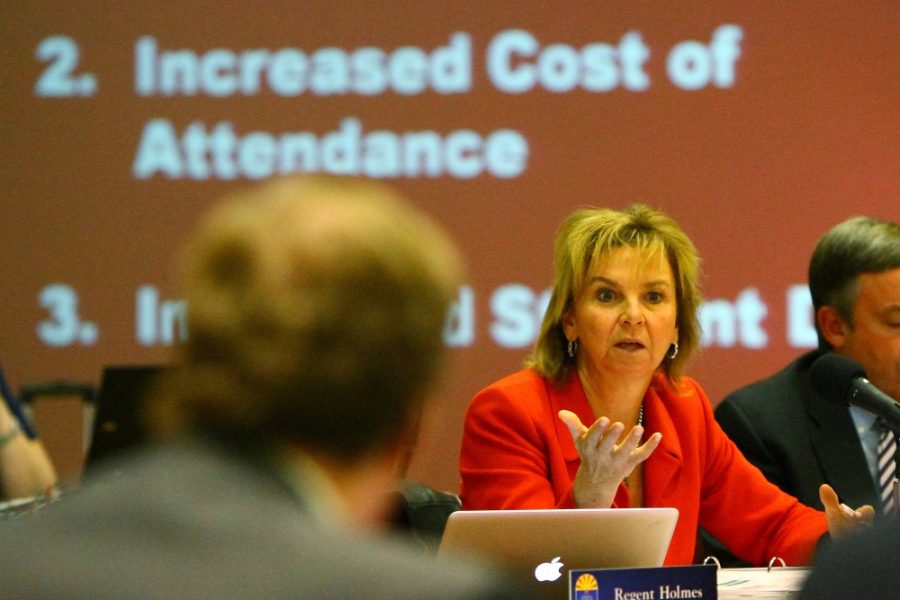For the Arizona Board of Regents, potential problems for the state’s financial aid system boil down to three factors: increased financial need, increased costs of attendance and an increased student debt load.
According to the board’s 2011 Financial Aid Report, the number of student loans in Arizona has increased 79 percent over the last five years. Magnifying that is a substantial increase in total financial aid allotments as enrollment continues to grow. Over the last five years, the amount of financial aid awarded within the Arizona university system has increased $745.7 million, or 75.4 percent. This increase largely comes from instiutional sources and student loans, according to the report.
During the board meeting on Thursday, Regent Anne Mariucci said she was concerned with the magnitude of student loans in the greater scheme of financial aid, and that she is wary of the possibility of a financial aid “bubble,” where students will find it necessary to take out loans and not be able to pay them back when they graduate.
“You live in this world where you are living with this misalignment every day,” Mariucci said. “Where is this headed, where does this end and how does this have a happy ending?”
Board Chair Fred DuVal said he shared some of Mariucci’s concerns, and could see a situation where continued increases in tuition could stretch the regents’ contributions to financial aid too thin, leading to an increased reliance on loans. DuVal said it is necessary for the board to continue reviewing board policy to address, and if possible, curtail these potential problems.
Regent Dennis DeConcini said he thinks it is important to convey concerns over the solvency of financial aid to the state Legislature. Regent Bob McLendon, who served as a state representative from 1982 to 2000, said that, in order to do so, the regents must stress the economic benefits of higher education.
“Folks at the Capitol need to understand that education … is indeed an investment and treat it as such instead of an expense,” he said.
McLendon said that, although there is no such thing as a “free lunch,” the importance of higher education merits state funding.
“It (higher education) needs to become a high priority, if not the highest priority,” he said.
Regent Mark Killian said dwindling state funding places an additional burden on students and their families.
“The policymakers have to decide how much they want education to cost, and what the trade off is to society,” he said.
Some suggested that students should take on larger course loads, or that the cutoff for financial aid eligibility be placed at 15 credit hours, not 12, per semester, since that’s the amount typically necessary to graduate in four years.
Dan Anderson, the regents director of institutional analysis, said the number of full-time equivalents at Arizona’s universities is greater than the system’s headcount enrollment for the first time in history. A full-time equivalent means someone who completes enough credit hours to be considered a full-time student, 12 per semester at the UA. That this number outpaces headcount enrollment means students are taking on larger course loads, Anderson said.
Anderson also presented statistics showing that, as of 2010, 80 percent of recent Arizona university graduates were employed, and that they made an average of 80 percent more than their peers. When prompted, Anderson estimated that this would equate to a 90 percent increase in owed state taxes as well.
“That sounds like a great way to raise taxes without raising taxes,” Killian said.
After discussion, the regents unanimously approved the 2011 Financial Aid Report.
Rodriguez contract approved
The football team got its man in Rich Rodriguez Thursday, but poor communication from the university got some of the regents riled up.
Regent Ernest Calderon raised concerns over how the details of the hiring became public, and the lack of input and oversight by the regents on the process.
“This approach is not acceptable,” Calderon said.
Calderon also moved that guidelines be set in order to ensure that regents are involved throughout the process of multi-year athletic contracts. Calderon specified that football, baseball, and men’s and women’s basketball be subject to that protocol.
“At the very end of the day, the governance role and accountability of the regents is paramount,” Calderon said.
UA President Eugene Sander said he supported the measure, and regrets the relative lack of regent input into the hire.
“Hopefully, we won’t have to be doing this soon in the future, but I do agree that it will be important,” Sander said.
Piling it on
When the board reconvened for its afternoon session, UA Student Regent William Holmes placed a UA pin on the lapel of Tyler Bowyer, the student regent from Arizona State University, the price of a lost bet over the outcome of the UA-ASU football game.
“If only my mom could see me now,” Bowyer said. “I hope she’s not watching.”









